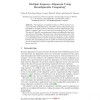BIOCOMP
2006
14 years 6 months ago
2006
Computation of multiple sequence alignments is one of the major open problems in computational molecular biology. The purpose of this study was to provide a new method, PAC (Progre...
GECCO
2006
Springer
14 years 8 months ago
2006
Springer
This paper proposes a hybrid genetic algorithm for multiple sequence alignment. The algorithm evolves guide sequences and aligns input sequences based on the guide sequences. It a...
ARC
2007
Springer
14 years 9 months ago
2007
Springer
The alignment of multiple protein (or DNA) sequences is a current problem in Bioinformatics. ClustalW is the most popular heuristic algorithm for multiple sequence alignment. Pairw...
RECOMB
1997
Springer
14 years 9 months ago
1997
Springer
We present a new polynomial time approximation scheme (PTAS) for tree alignment, which is an important variant of multiple sequence alignment. As in the existing PTASs in the liter...
RECOMB
1997
Springer
14 years 9 months ago
1997
Springer
Multiple sequence alignment is an important problem in computational biology. We study the Maximum Trace formulation introduced by Kececioglu [?]. We first phrase the problem in ...
CPM
1998
Springer
14 years 9 months ago
1998
Springer
d abstract) John Kececioglu and Dean Starrett Department of Computer Science The University of Arizona Tucson AZ 85721, USA A basic computational problem that arises in both the...
STOC
2000
ACM
14 years 9 months ago
2000
ACM
Multiple sequence alignment is a fundamental problem in computational biology. Because of its notorious difficulties, aligning sequences within a constant band (c-diagonal) is a ...
IPPS
2002
IEEE
14 years 10 months ago
2002
IEEE
This paper is concerned with the efficient execution of multiplesequence alignmentmethodsin a multipleclientenvironment. Multiple sequence alignment (MSA) is a computationally ex...
GECCO
2003
Springer
14 years 10 months ago
2003
Springer
This article presents a model for DNA sequence alignment. In our model, a finite state automaton writes two-dimensional maps of nucleotide sequences. An evolutionary method for se...
GECCO
2003
Springer
14 years 10 months ago
2003
Springer
In this paper we present an approach that evolves the consensus sequence [25] for multiple sequence alignment (MSA) with genetic algorithm (GA). We have developed an encoding schem...







